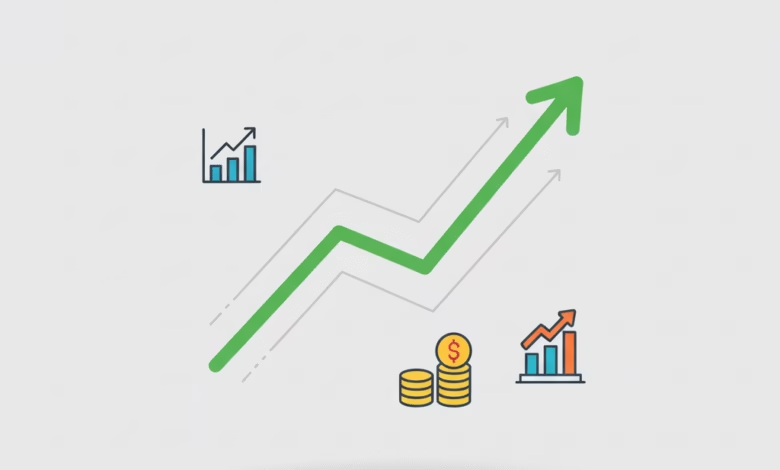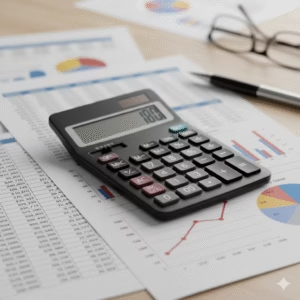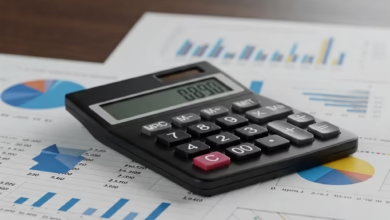Should I invest or save during the holiday season?
Understand which choice to make: investing or saving during the holiday season

The holiday season is upon us. It’s a time of joy, family, and celebration. It’s also, let’s be honest, a time of intense financial pressure.
Between gifts, travel, parties, and charitable giving, the last two months of the year can feel like a financial marathon. At the same time, the “New Year, New Me” energy is building. We’re thinking about our goals for the coming year, and for many of us, those goals are financial: save more, invest wisely, and build wealth.
This creates a powerful conflict: With holiday spending on one side and New Year’s resolutions on the other, what should you do with any “extra” money you have right now? What about your year-end bonus? Should you save it for a rainy day, or should you invest it to grow your future?
It’s a question that can paralyze even the most well-intentioned person. The truth is, there is no single right answer. The best strategy for you depends entirely on your current financial health.
This article will serve as your definitive guide to navigating this decision. We’ll break down the difference, explore the risks and benefits of each, and give you a clear, step-by-step framework to make the smartest choice for your money this holiday season.
What’s the Real Difference Between Saving and Investing?

Before we can decide what to do, we must be crystal clear on our terms. “Saving” and “investing” are often used interchangeably, but they are fundamentally different concepts with different goals.
Saving is for the short term. Investing is for the long term.
Think of it this way:
- Saving: This is the act of putting money aside in a safe, easily accessible place. The primary goal of saving is capital preservation (not losing your money) and liquidity (getting to it quickly when you need it).
- Goal: Emergencies, a down payment on a car, your holiday gift budget, or a vacation next year.
- Where it goes: A High-Yield Savings Account (HYSA), a certificate of deposit (CD), or a money market account.
- Risk: Extremely low. Your money is typically FDIC-insured (up to $250,000) and won’t go down in value.
- Return: Very low. You might earn some interest, but it’s often just enough to (maybe) keep up with inflation.
- Investing: This is the act of using your money to buy assets that have the potential to grow in value over time. The primary goal of investing is capital growth—making your money work for you.
- Goal: Retirement, your kids’ college education, or building long-term, generational wealth.
- Where it goes: The stock market (via 401(k)s, IRAs, individual stocks, or ETFs), real estate, or bonds.
- Risk: Variable to high. The value of your investments can (and will) go down, but over a long time horizon, the market has historically trended up.
- Return: Potentially high. You are taking on risk in exchange for the potential of returns that significantly outpace inflation.
The holiday season blurs this line. You might be “saving” for holiday gifts, which is really just a short-term spending plan. The real dilemma is what to do with money beyond your immediate holiday budget.
Before You Invest a Dime: Assess Your Holiday Financial Health
You can’t plan a road trip without knowing your starting point. Before you even think about investing, you need to perform a quick financial “triage.” Be honest with yourself and see where you stand on these three critical items.
1. Do You Have High-Interest Debt?
This is the big one. We’re talking about credit card debt. If you are carrying a balance from month to month with an average APR of 18%, 22%, or even 28%, this isn’t a question.
Paying off high-interest debt is the single best, guaranteed “investment” you can make.
Think about it: Paying off a 22% APR credit card is like earning a guaranteed, tax-free 22% return on your money. You will not find that kind of guaranteed return anywhere in the stock market. Before you invest a dollar, every available cent should go toward eliminating this debt. Using a holiday bonus to wipe out a credit card balance is the most powerful financial move you can make.
2. Do You Have a Holiday Spending Plan?
The fastest way to derail your financial goals is to enter the New Year with a “financial hangover.” This happens when you don’t budget for the holidays and wake up in January to a credit card bill that makes your stomach drop.
Before you save or invest, you must have a clear budget for gifts, travel, and food. This money should be set aside in cash or a separate checking account. This is not “saving”; this is “planned spending.” If you don’t have this covered, that’s your first job.
3. Do You Have an Emergency Fund?
This is the foundation of all financial security. An emergency fund is 3-6 months’ worth of living expenses set aside in a liquid, high-yield savings account.
This is the money that saves you when your car breaks down, your water heater explodes, or you face an unexpected job loss. Without an emergency fund, any unexpected event will force you into debt (see #1) or force you to sell your investments at the worst possible time.
If your emergency fund is looking thin (or is non-existent), building it up is your top priority after paying off high-interest debt.
The Strong Case: Why Saving Should Be Your Top Priority This Holiday Season
For the vast majority of Americans, saving is the clear winner, especially during this high-spend season. Here’s why.
1. It’s Your Defense Against the “January Financial Hangover”
The holidays are an emotional time, and emotional spending is dangerous. It’s incredibly easy to overspend, relying on the vague idea that “I’ll just pay it off in January.” This is a trap that creates a cycle of debt.
By prioritizing saving, you are building a buffer. When you have a solid savings account, you aren’t tempted to swipe the credit card for that “one last gift.” It gives you control and prevents you from starting the New Year in a financial hole.
2. Peace of Mind is the Best Gift You Can Give Yourself
The holiday season can be stressful. Adding financial anxiety on top of it is a recipe for misery. Knowing you have a fully-funded emergency fund provides a level of peace and security that no hot stock tip ever will.
This peace of mind allows you to genuinely enjoy the holidays with your family, knowing that you are financially secure. If 2020 taught us anything, it’s that the unexpected will happen. A robust savings account is your personal insurance policy against chaos.
3. You’re Building the Foundation for Future Investing
You cannot build a strong house on a foundation of sand. In this analogy, saving is your concrete foundation, and investing is the house you build on top of it.
If you jump straight to investing without an emergency fund, you are building a house of cards. The first sign of trouble—a medical bill or a pay cut—will force you to sell your investments, likely at a loss, just to cover basic expenses. This is how people lose money in the market.
A strong savings buffer is what allows you to invest for the long term. It gives you the confidence to ride out market downturns without panicking, because you know your short-term needs are completely covered.
When Does Investing Make Sense at Year-End?

So, is there ever a case for investing during the holidays? Absolutely. But it’s for a specific group of people who have already passed the financial health check.
You should only consider investing at year-end after you have:
- Paid off all high-interest debt.
- Fully funded your holiday spending budget.
- Established a healthy emergency fund (at least 3-6 months of expenses).
If you’ve checked all three of those boxes, congratulations! You are in a fantastic financial position. Here is how to think about investing your surplus.
1. The Year-End Bonus: A Perfect Opportunity
If you receive a year-end bonus, it can feel like “free money.” This is a psychological trap. The best way to handle a windfall like a bonus is to have a plan before it hits your account.
A great strategy is the “50/30/20” bonus plan:
- 50% to your biggest financial goal: This is where investing comes in. Use half to max out your IRA or add to your brokerage account.
- 30% to savings: Beef up your emergency fund, save for a down payment, or fill another savings bucket.
- 20% to “fun”: Use this to enjoy the holidays! Buy a nicer gift, take a small trip, or treat yourself to a nice dinner. This prevents you from feeling deprived and helps you stick to your plan.
2. Maxing Out Your Tax-Advantaged Accounts
This is the most powerful reason to invest at year-end. The government gives you significant tax breaks for saving in retirement accounts, and these have deadlines.
- 401(k) or 403(b): You have until December 31st to meet the annual contribution limit through your paycheck. If your bonus is paid through payroll, you can often ask your HR department to allocate a large portion of it directly to your 401(k) to max it out. This lowers your taxable income for the year and builds your retirement nest egg.
- IRA (Traditional or Roth): You technically have until the tax-filing deadline (usually April 15th of the next year) to contribute for the current tax year. However, acting at year-end is a smart habit. If you have extra cash, funding your IRA is a phenomenal use of that money.
3. The “Santa Claus Rally” and Dollar-Cost Averaging
You may hear financial news talk about the “Santa Claus Rally,” a “market phenomenon” where stocks tend to rise in the last week of December.
You should ignore this. Trying to time the market is a fool’s game.
A much, much smarter strategy is Dollar-Cost Averaging (DCA). This just means investing a fixed amount of money at regular intervals (e.g., $200 every month), regardless of what the market is doing.
If you already have an automated investment plan, do not stop it for the holidays. Don’t pause your 401(k) contribution “just for December.” This is the most common mistake people make. That small, missed contribution breaks your discipline and costs you valuable compound interest. The best time to invest is always “now,” and the best way is systematically.
Your Step-by-Step Guide: How to Allocate Your Money This Holiday Season
Okay, let’s put it all together. Here is a simple, 5-step priority list. Start at Step 1 and only move to the next step once the previous one is complete.
- Step 1: Create a Holiday Spending Budget.
- Action: Write down every single person you need to buy a gift for and set a firm dollar limit. Add up costs for travel, extra food, and parties. This is your “Holiday Fund.”
- Goal: Have this amount in cash or a checking account, ready to be spent without guilt or debt.
- Step 2: Attack High-Interest Credit Card Debt.
- Action: Gather all your credit card statements. Target the one with the highest APR first (the “avalanche method”).
- Goal: Use any extra money, including a bonus, to pay this down as aggressively as possible. Do not pass Go, do not invest $100, until this is under control.
- Step 3: Build Your “Starter” Emergency Fund.
- Action: Open a High-Yield Savings Account (HYSA) at a separate bank (so you’re not tempted to touch it).
- Goal: Save at least $1,000 or one month’s worth of living expenses. This is your “starter” fund. Your long-term goal is 3-6 months, but this initial buffer is non-negotiable before investing.
- Step 4: Maximize Tax-Advantaged Investments.
- Action: Check your 401(k) contributions for the year. Check your IRA.
- Goal: If you have debt and savings covered, use your extra year-end money to get as close to the annual contribution limit as possible. This is the most efficient form of investing.
- Step 5: Invest in a Taxable Brokerage Account.
- Action: Only after all four steps above are complete should you open a standard brokerage account.
- Goal: Use this money for long-term goals outside of retirement. A simple, low-cost index fund (like an S&P 500 ETF) is a perfect place to start.
Mind Over Money: Avoiding Common Holiday Financial Traps

Our brains are not wired to be rational about money, especially when emotions are high. Be on the lookout for these common psychological traps.
- The Trap: “It’s just a bonus, it’s ‘fun money’!”
- The Fix: Reframe it. A bonus is not lottery winnings. It is money you earned for your hard work all year. It deserves the same respect as your regular paycheck. Treat it with a plan (like the 50/30/20 rule) rather than as “found money.”
- The Trap: “I’ll just put the gifts on my 0% APR card and pay it off later.”
- The Fix: This is a dangerous gamble. “Later” often never comes. A 0% introductory offer is a useful tool for a planned, large purchase, but it’s a terrible excuse for unplanned overspending. If the introductory period ends and you still have a balance, the interest hits you all at once. Budget and pay with cash you have now.
- The Trap: “I have to stop my 401(k) contributions in December to afford gifts.”
- The Fix: This is a classic short-term solution that creates a massive long-term problem. That $200 you missed contributing could have grown to $2,000 or more by retirement. It’s far better to cut your gift budget by $200 than to steal from your future self.
The Best Financial Gift You Can Give Yourself This Year
The debate between saving and investing during the holidays is really a question of financial priorities.
For 90% of people, the answer is clear: Focus on saving. Build your holiday spending fund to avoid debt. Attack any existing credit card debt like your life depends on it. And build that emergency fund to give yourself the gift of financial peace.
For the 10% who have already built that solid foundation, the end of the year is a critical time to invest wisely. Use your bonus or extra cash to max out your tax-advantaged retirement accounts (401k, IRA).
The goal isn’t to get rich overnight. The goal is to end the year in a stronger, more resilient financial position than you started. Entering the New Year with zero new debt, a solid savings buffer, and a consistent investment plan is the single most valuable gift you can give yourself—one that will keep on giving for decades to come.





